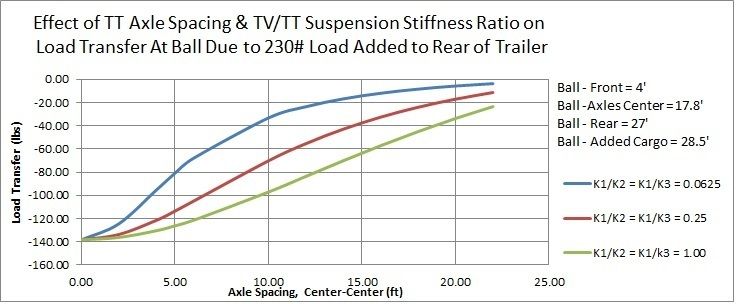TundraTower wrote:
1. You summed the moments around the axis of the coupler ball, but in order to create a load at the WDH ell brackets (F1 in your equation) the WDH hitch has to be engaged and the tongue jack retracted. When you do that the truck and trailer become one rigid member and you then have to consider the loads at the TV wheels in this sum of the moments and the equation has two more elements.
2. Where were you going to get the constant F1, the load applied to the A frame by the WDH ell brackets? This was exactly the point of my comment - we don't know that number.
The load applied to the A-Frame usually is established by trial and error -- changing ball mount tilt and/or number of chain links under tension (or raising/lowering L-brackets in case of Equal-I-zer).
When the desired amount of load transfer is achieved, you have established the value of F1 without needing to know its value.
When the bars are engaged and you retract your tongue jack and everything settles, a good bit of the classic tongue weight on the ball is transferred back to these L brackets PLUS a moment force is created at the hitch (about 750-800 foot lbs for my case) which is what forces weight back to the TV front wheels.
Actually, the magnitude of downward force on the L-brackets (or lift chains) is considerably more than the tongue weight.
In my example, it was necessary to transfer 250# to the TT's axles to cause the desired 500# to be transferred to the TV's front axle.
Let's assume the distance from TV rear axle to ball is 60" and the distance from ball to TT axles midpoint is 200" (giving the assumed rear axle to TT axles distance of 260").
Also, let's assume the distance from ball to L-bracket or lift chain is 30".
Then, the formula, F2 = F1*d1/d2, can be changed to F1 = F2*d2/d1 = 250*200/30 = 1667# (total for 2 WD bars).
The combined bar force acting over the moment arm of 30" generates a moment of 1667*30 = 50,000 lb-in.
The downward force of 1667# on the A-frame is balanced by the 250# which was transferred to the TT axles and by a downward force of 1667-250 = 1417# added to the ball.
At the same time, the front ends of the WD bars push upward against the ball mount with a combined force of 1667#.
The upward force of 1667# minus the 1417# which was added to the ball yields a net upward force of 250# acting on the hitch head.
This 250 acting over the assumed rear axle to ball distance of 60" yields an additional moment of 250*60 = 15,000 lb-in.
Adding the 50,000 lb-in of direct moment plus the 15,000 lb-in from net upward force on hitch head gives a total moment about the TV's rear axle of 65,000 lb-in.
Dividing this moment by the 130" wheelbase gives a load of 500# added to the front axle.
This simply shows that WD load transfer calculations can be done in more than one way.
The method I outlined in my previous post treated the combined TV and TT as a single body with external forces acting at 1) TV front axle, 2) TV rear axle, and 3) TT axle(s).
The method presented in this post, follows your model of treating just the TV and hitch with a moment input and a force input applied to the hitch head and vertical reactions at the front and rear axles.
There is no best way of approaching the problem -- as long as all approaches give the same (correct) result.
The force transferred to the ell brackets as things settle from unloaded to loaded state depends on the spring rate of the WDH bars and the spring rate of your truck suspension, neither of which is linear, and neither of which is really known by us.
The spring rate of a WD bar is essentially linear -- as long as you don't exceed the elastic limit. However, linear or not doesn't make any difference because you adjust the WDH to give the desired results -- the bars bend as much as they need to bend.
The spring rate of the truck suspension also doesn't make any difference. With only two axles, you have a completely deterministic system and displacements don't enter into the calculations.
Ron, please don't take offense at the comments. This is an absolutely fascinating analysis. I'm 42 years out of college but it is still just Statics 101, and I recognize I may be making it more complicated than it is as we try to visualize the free body diagram and forces around the WDH.---
I thoroughly enjoy receiving intelligent comments such as yours. I almost always learn something new when answering (or trying to answer) someone's questions.
Also, I'm 47 years out of college and my aging brain cells need all the exercise they can get.
Ron
